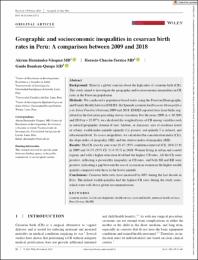Geographic and socioeconomic inequalities in cesarean birth rates in Peru: A comparison between 2009 and 2018

View/
Download
(application/pdf: 772.4Kb)
(application/pdf: 772.4Kb)
Date
2021-07-08Author(s)
Hernández-Vásquez, Akram
Chacón-Torrico, Horacio
Bendezu-Quispe, Guido
Metadata
Show full item recordAbstract
Background
There is a global concern about the high rates of cesarean birth (CB). This study aimed to investigate the geographic and socioeconomic inequalities in CB rates in the Peruvian population.
Methods
We conducted a population-based study using the Peruvian Demographic and Family Health Surveys (ENDES, the Spanish acronym for Encuesta Demográfica y de Salud Familiar) between 2009 and 2018. ENDES reported data from births registered in the five years preceding survey execution. For the years 2009 (n = 10 289) and 2018 (n = 23 077), we calculated the weighted rates of CB among variables such as natural geographic domain (Coast, Andean, or Amazon), area of residence (rural or urban), wealth index quintile (quintile 1 is poorest, and quintile 5 is richest), and educational level. To assess inequalities, we calculated the concentration index (CIs), the slope index of inequality (SII), and the relative index of inequality (RII).
Results
The CB rates by year were 21.4% (95% confidence interval [CI]: 20.0-22.9) in 2009 and 34.5% (95% CI: 33.4-35.5) in 2018. Women living in urban and coastal regions and with a higher education level had the highest CB rates. All the CIs were positive, reflecting a prowealthy inequality in CB rates, and both SII and RII were positive, indicating a gap between the use of cesarean in women in the higher wealth quintile compared with those in the lower quintile.
Conclusions
Cesarean birth rates have increased by 60% during the last decade in Peru. The richest wealth quintiles had the highest CB rates during the study years, which were well above global recommendations.
Collections
- SCOPUS [380]

